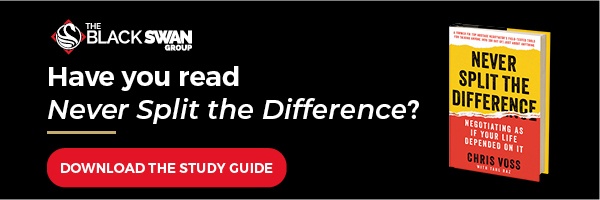Most of us want to get better at negotiation. And when we think of where to start after reading Never Split the Difference, the obvious choice for the first technique to try to get comfortable with is mirroring. “Repeat the last few words they say back to them.” Easy enough. Right?
However, it is not until we learn and practice the labeling technique that we are truly hooked. By attaching an identifying label to our counterpart’s words, it shows them that we are attempting to gain an understanding of the position they are in. 
And wham! They suddenly feel understood by us, and like a steam train (wherein the train is collaboration, labeling is the coal, and rapport is the steam), labeling causes rapport to build, making collaboration among the parties involved move full speed ahead.
How Labeling Helps Us Gain Understanding
Labeling is a technique that allows us to attach a tentative identifier to the dynamics, emotions, or circumstances implied by your counterpart’s words and actions. It shows that we are attempting to gain an understanding of their message.
It is a very powerful and exciting skill because it helps us—almost as if it were a Jedi mind trick—to successfully discover the hidden factors and emotions that are driving the other side at the negotiation table.
Labeling gets us hooked because most of the time, our counterpart will show excitement when feeling understood. Many of our clients tell us that when they get someone talking using labels, the conversation usually takes them somewhere they have never been before.
They enter a territory of counterparts’ self-disclosure and discoveries of black swans that are helpful to the negotiation. Once, while I was negotiating with a considerably assertive and angry individual on the phone, I started using labels, and after a few minutes of this, his tone shifted from a negatively emotional charge to a collaborative one.
It took me by surprise. Because he felt understood, labels transformed his negative thinking into positive thinking. Collaboration became a viable option! Soon thereafter, he was not only calling me by my first name, but he also openly agreed to the terms of the deal.
How to Master the Labeling Technique
When delivered properly, a label is one of the most powerful tools in your Tactical Empathy™ toolkit. A positive tone, ending with inflections that connote genuine curiosity, is extremely effective. The effectiveness of a label cannot be underestimated. Not only does it create a collaborative atmosphere, but it can also keep negative emotions from hijacking the negotiation.
To master the labeling technique, you have to get your reps to allow it to become second nature. To use this technique successfully, the focus must be on your counterpart.
The crucial thing is not what you want to say next. The important questions to answer are: What are the core values identified with what they are telling me? Am I listening for the motivations and/or dynamics underneath the surface?
Labeling and Empathy
Lastly, labeling is one of the best ways to show empathy. People have a natural desire to be heard and understood. By starting with It feels, it seems, it sounds like, and proper tone delivery, you’re not only helping the other person express a perceived problem, but you’re also minimizing your chances of being seen as a threat.
Communication occurs on two levels: the facts and content as told by the other side and how the person feels about what was just said.
By using labels, you are demonstrating that you are trying to understand their perspective without making assumptions. You are helping them become problem solvers. The great thing about labeling is that you can make mistakes!
People will almost instantly correct you. It is the attempt to get it right that the person on the other side will appreciate. Labeling will help you get clear statements, establish a collaborative relationship through effective communication, enable a problem-solving atmosphere, and free you from their assumption that you’re blocking them from their needs, interests, or goals.


